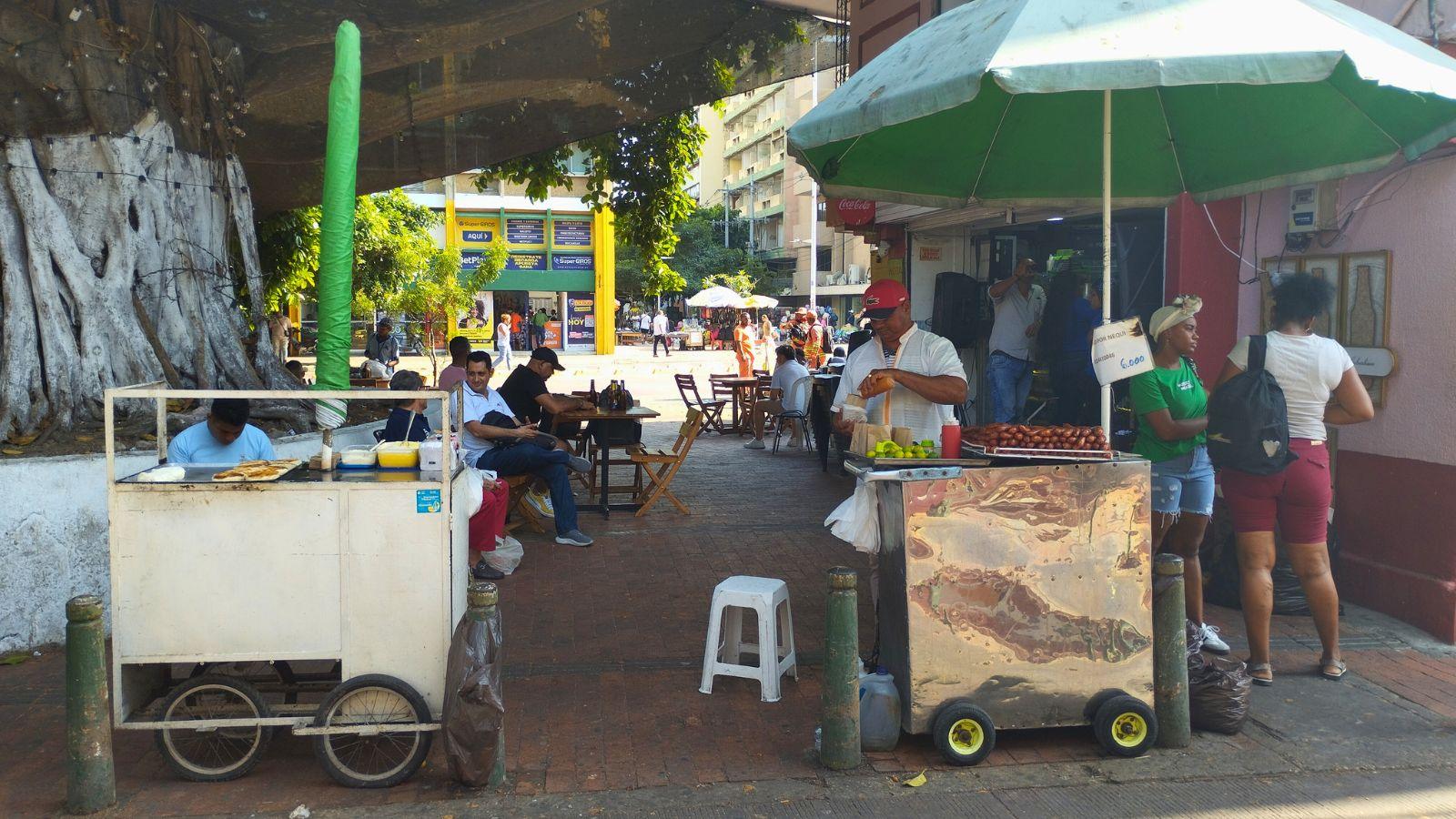Cartagena, with its hot and humid climate, is lived in the street, and that’s also where you feel its essence and flavor. Street food, juices and snacks stalls crowed the squares and sidewalks, impregnating the corners with a unique smell of cheese arepa and lemonade.
I can assure you that you will notice it as soon as you arrive in Cartagena de Indias, mingling with the vibrant street atmosphere that fills with sounds, smells and tastes from sunrise until late at night. With its colonial influence and hectic history, this Caribbean city in Colombia is a delight for the palate, and if you don’t believe me, just ask anyone who has tasted its fruits, cocktails and seafood.
There are many typical dishes in Cartagena de Indias, but there are also traditional and quick options to eat on the street between strolls. Here you will get to know about the best and most typical street food in Cartagena de Indias for you to try while you get to know the city!
Shrimp coktails: a must-try street food in Cartagena de Indias
Cartagena is all about cocktails, and not just the alcoholic ones, but those made with seafood. Although you can find them in different parts of the city, the most famous area is Calle 32, next to Avenida Venezuela and a few steps from Plaza de la Paz, where the stalls form a line, with some a little further along.
While it is not ceviche, it is very close in that it is refreshing and ideal in a city as hot as Cartagena. It is prepared by mixing the seafood with a sauce based on ketchup, mayonnaise, lime juice, garlic water, chopped onion and cilantro, and served with crackers.
There are several sizes to choose from, depending on the type of glass, and you can see the prices on the containers themselves. Best of all, you can mix and match different types of seafood.
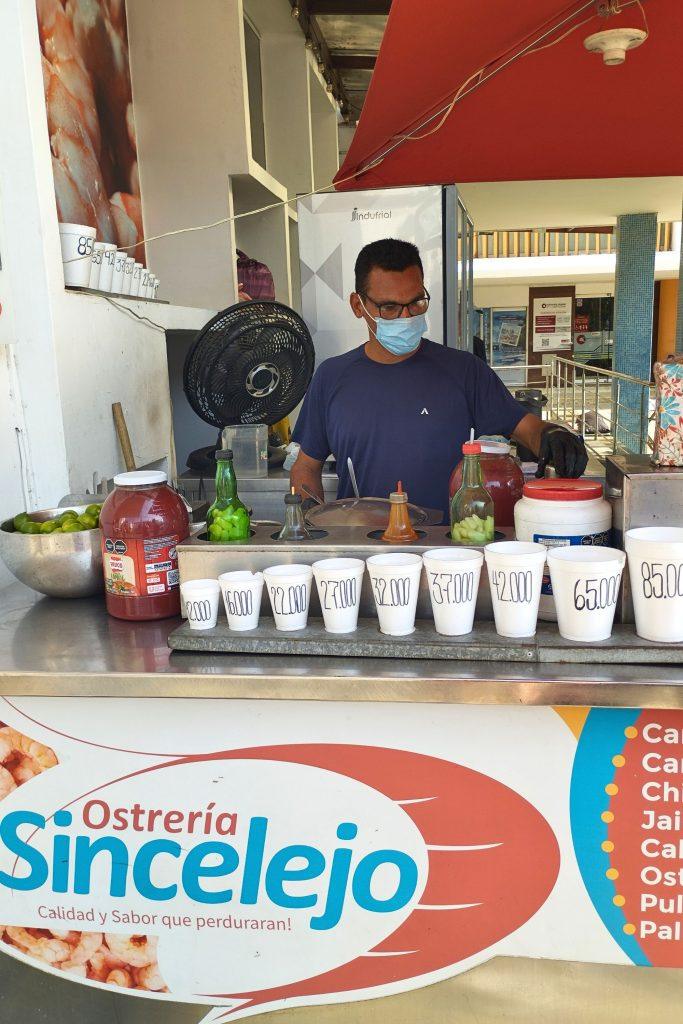
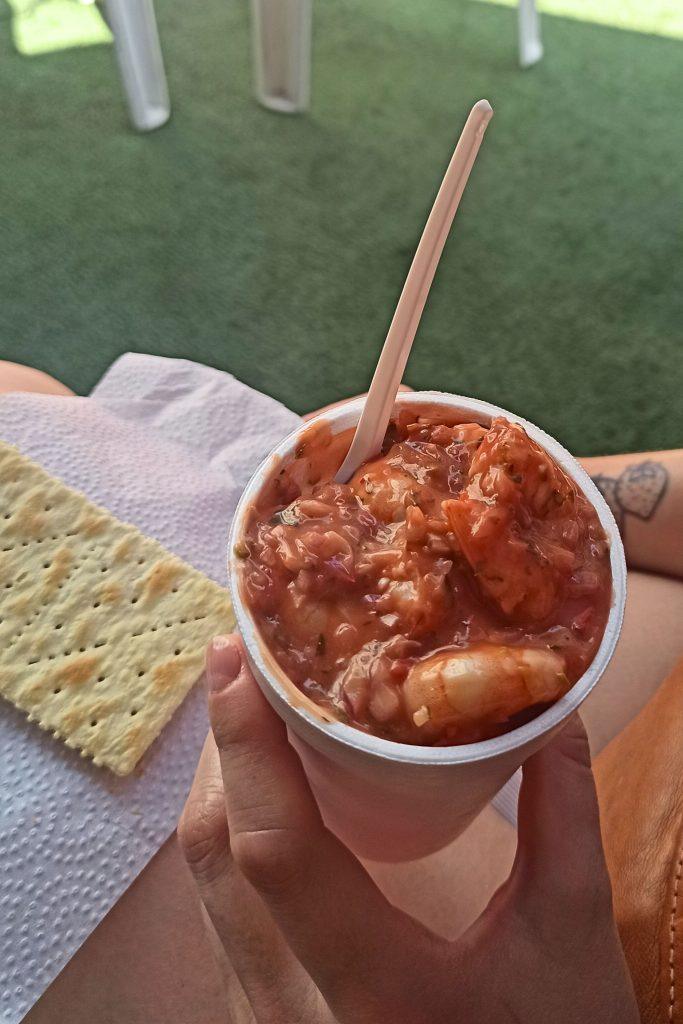
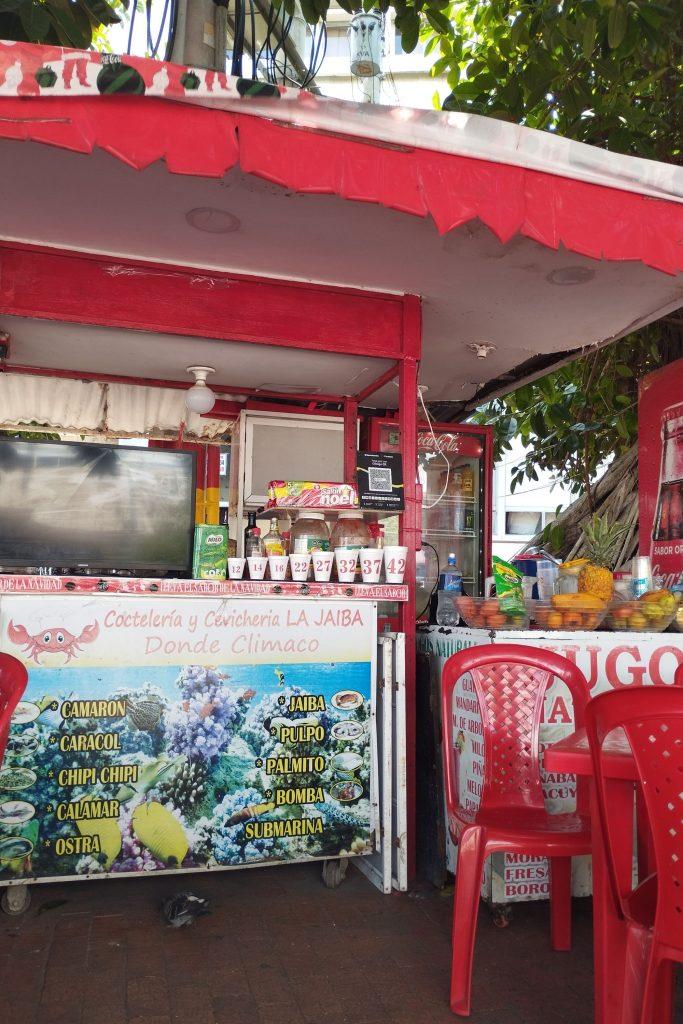
Being good seafood freaks – me – and shrimp freaks – my partner -, we ate at no less than three different places in a span of two days, with the aim of comparing quality and taste, and the truth is that all of them met our expectations.
We tried Ostrería el Sombrerón, La Jaiba and Ostrería Sincelejo; in all three we ordered the shrimp cocktail, but we also had one with crab and another with chipi chipi – mini clams -, oysters and snails.
My recommendation: ask for the small glasses and try the Cartagena cocktail at different stands. For me, this is without a doubt the best typical street food in Cartagena de Indias, you will be amazed!
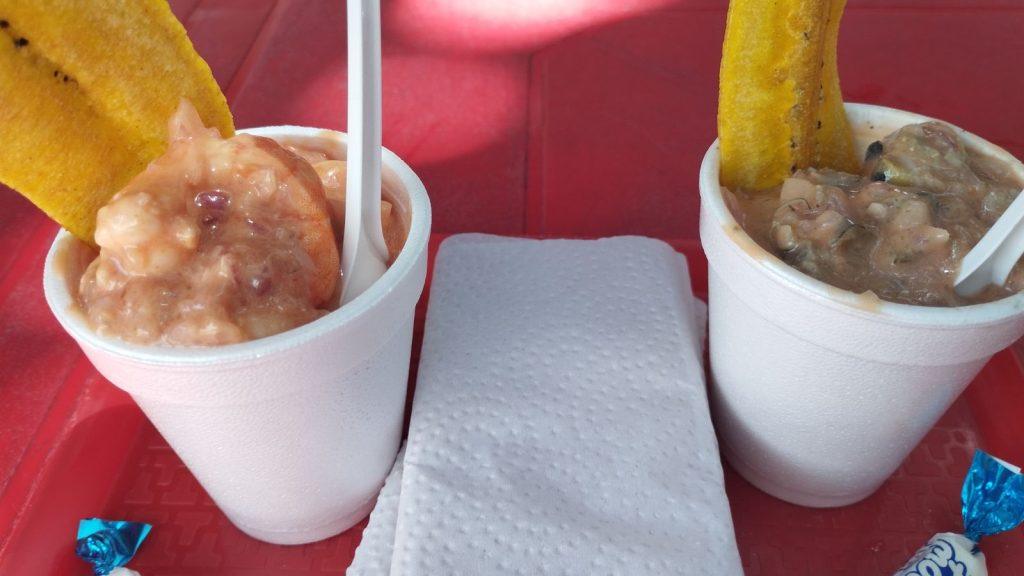
Fruit juices
Juices in Colombia are an integral part of everyday life, part of every menu, and unlike other drinks – coffee is usually served hot, soft drinks are carbonated, beer has alcohol -, it is healthy, refreshing, rich and varied.
In addition, there are all kinds of flavors, with a predominance of exotic fruits: sapote – the star fruit of Cartagena -, lulo, mango, soursop, passion fruit, melon, blackberry, guava, tree tomato…
If there is one place in Cartagena that I went to every day, two or three times, it was the refresquería Junior in the Mercado de las Flores. Top! For only 6,000 pesos, the glass of juice they serve with fresh fruit mixed with water or milk is enough to take your hat off. Choose it with a water base if you like them lighter and with milk if you like the consistency of a milkshake.
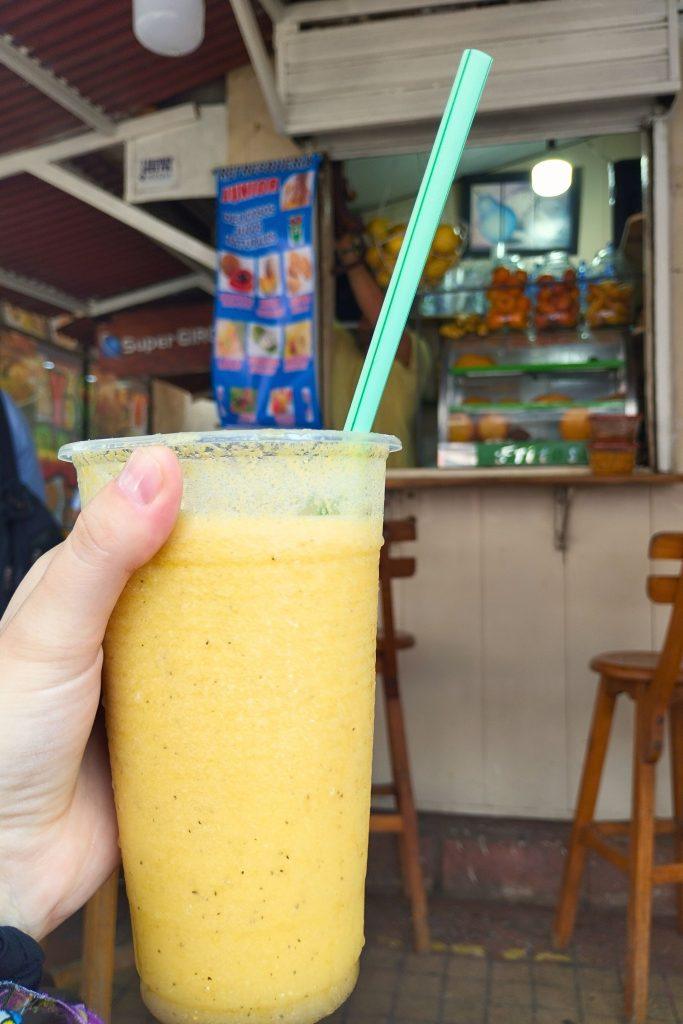
Cheese, corn or egg arepas
One of the great stars of the streets of Cartagena and one of the allies if you are looking for cheap food in Cartagena de Indias, with a characteristic smell that permeates everything, is the arepa. And although there are all kinds, there are three that are very typical of Cartagena.
Cheese arepas and egg arepas are savory; usually you’ll find the cheese ones because of their smell – it’s unique! -. If you find yourself walking around and wondering what smells so good, there is probably a cheese arepa cart nearby – and they are arepas made with corn flour, filled with fresh cheese and spread with butter.
Arepas de huevo are fried arepas that are cut open, filled with egg and usually minced meat, and then fried again. It is common to find them in street stalls, epecially fried food stalls, and they combine perfectly with a Colombian carimañola.
The arepas de choclo, sweeter, resemble a pancake and reminded me a lot of the Venezuelan cachapa. The price is around 5,000 pesos and they are very easy to find.
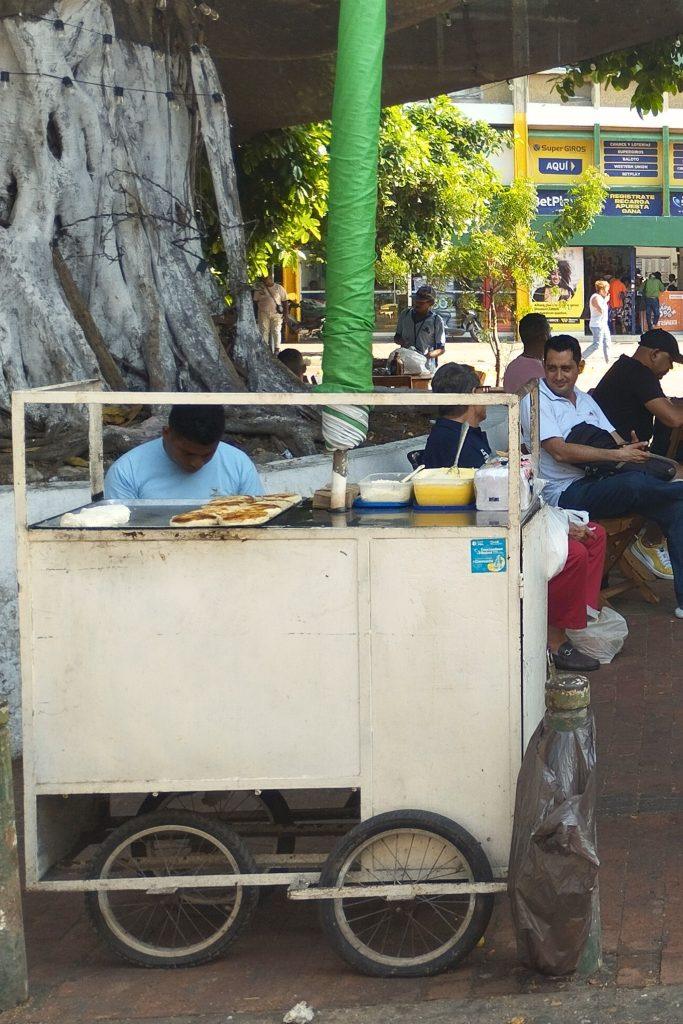
Fried foods: carimañolas, empanadas, stuffed potatoes, meatloaf…
In your first hours in Colombia, you will notice that fried foods are very popular in this country, especially in the street food of Cartagena, but also in bakeries and restaurants. For breakfast, as a snack during the day, with several pieces marking up a dinner…
The possibilities are endless and the fillings give rise to all kinds of combinations and flavors, so you can find arepas of a thousand kinds and empanadas of many others. There are also influences from other countries, such as the Lebanese kibbeh, which often fills the display cases, although the arepas are usually the king.
Although they may note be as typical in the rest of the country, carimañolas – made with a cooked yucca dough stuffed with meat, cheese or other ingredients – and arepas de huevo are very popular in Cartagena de Indias. One of the most famous places to try typical Cartagena fritos is at Los fritos de Dora, a traditional street stand located in the Plaza San Diego in the neighborhood of the same name.
Walking through the streets of the center of the walled city, you will also see a variety of stands, perfect for filling your stomach between cocktails. Prices vary from 1,000 to 10,000 pesos, depending on what and where you buy.
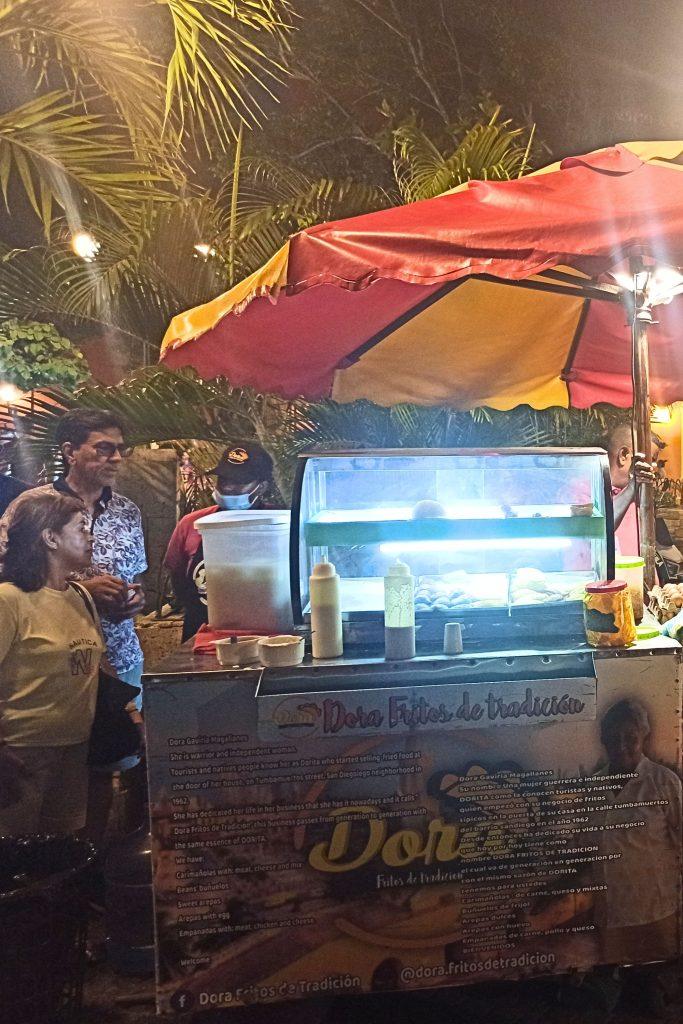
Tropical fruits
As in all Colombian cities, the gastronomy of Cartagena de Indias also includes tropical fruits, very attractive thanks to the vendors who walk around with their carts full of different and colorful fruits, ready to prepare the best snack for you. The mango biche is one of the most delicious, especially when prepared with salt, black pepper, chili and lime juice.
You can also try watermelon, pineapple, melon, soursop, the typical sapote and many more. As for the price, don’t be fooled; we paid double what the guide of our city tour recommended, who said you shouldn’t pay more than 10,000 pesos for a small glass of fruit, but it can start at 6,000 pesos.
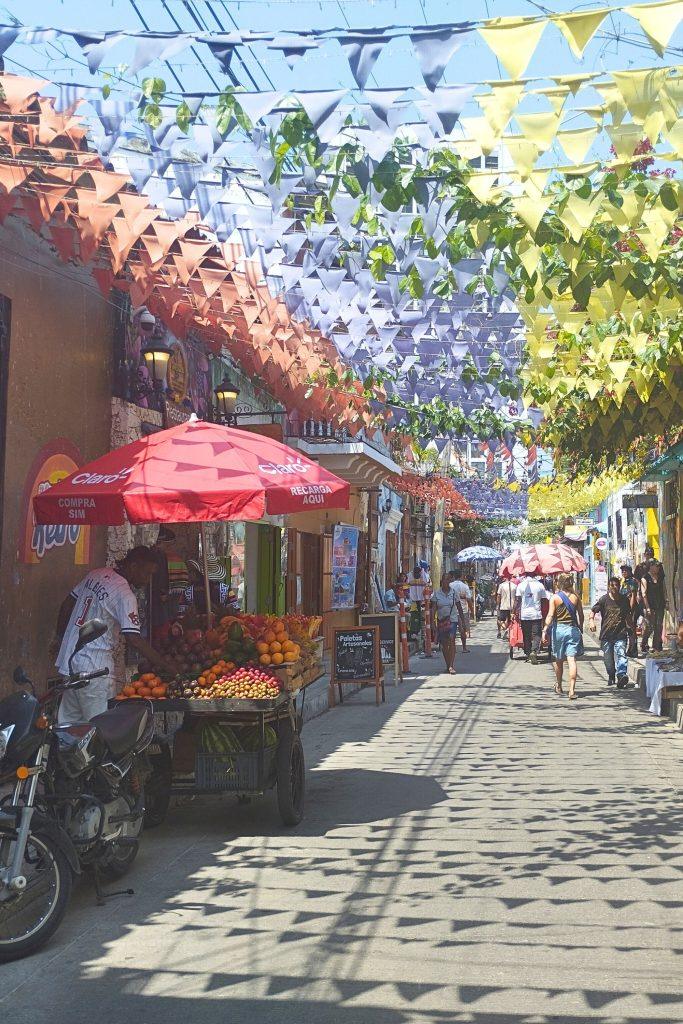
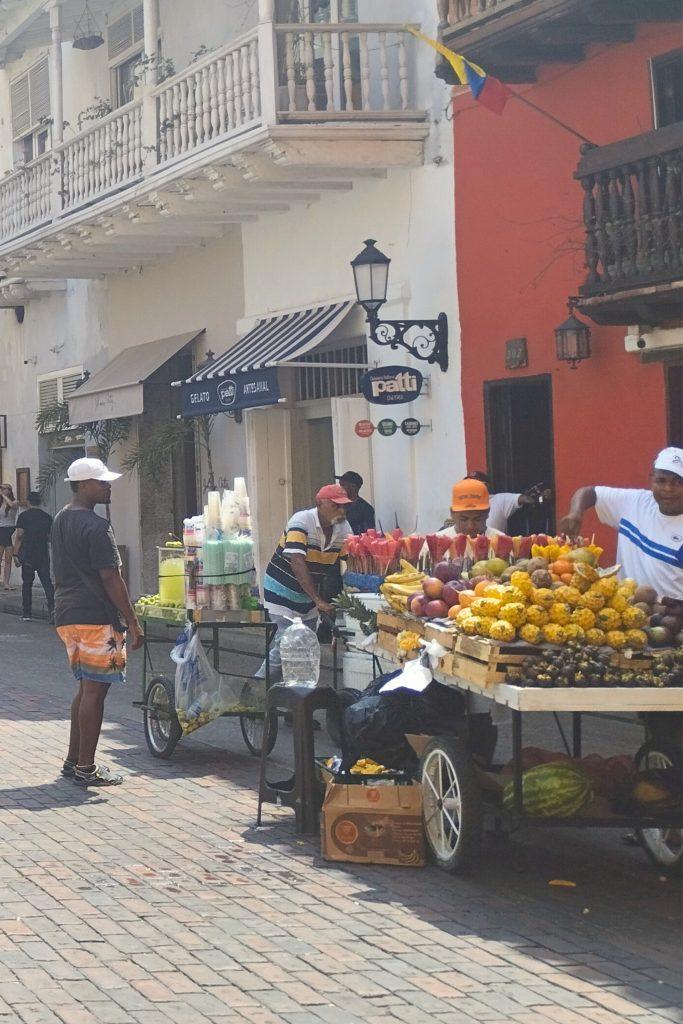
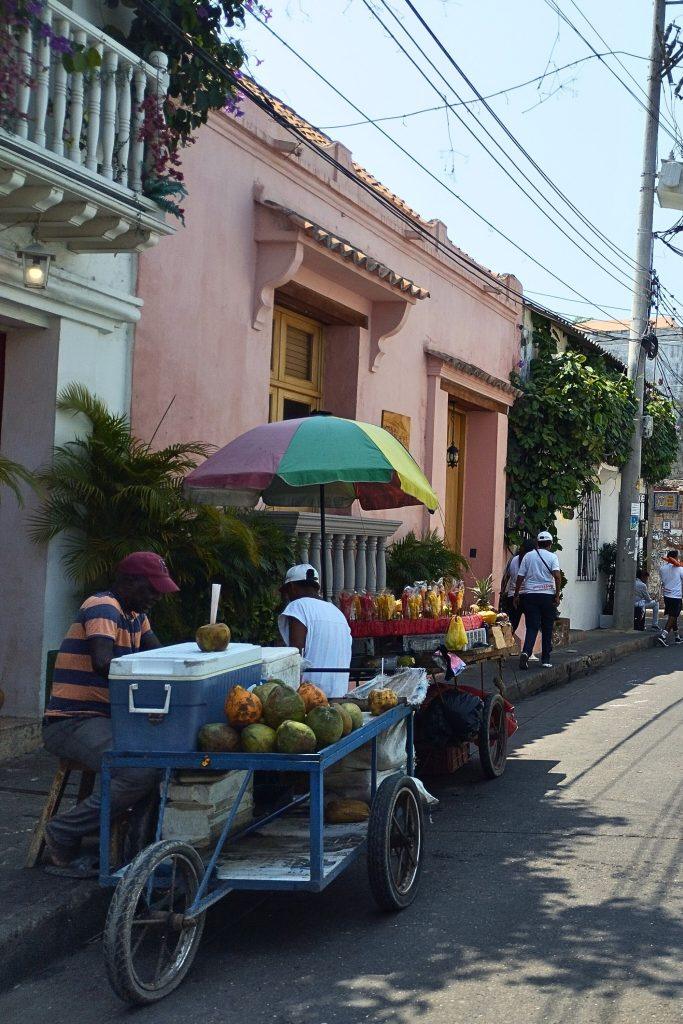
Patacones plain or with cheese
Typical of the Atlantic part of Colombia, the patacon is one of the great kings of street food in Cartagena de Indias. Consisting of fried, ripe plantain dough, it is fresh, crunchy and comforting. Although in many other cities it is typically served thinner, either as an accompaniment to another dish – like trout in Salento – or as a unique dish with other ingredients on top, here it is cooked and eaten in the original way.
The more you eat, the more you realize that everyone cooks patacón in their own way, and in Cartagena it is almost obligatory to serve it with cheese. To try it, in front of the Parque Centenario, on the left after crossing the Puerta del Reloj, there is a stand with 40 years of tradition where this delicacy is served. It is the Kiosko Palito de Caucho, gastronomic heritage of the city, essential if you want to know Cartagena de Indias through its typical street food.
The price is usually around 5,000 pesos and you can find them in street stalls, markets or restaurants – as an accompaniment to main dishes.
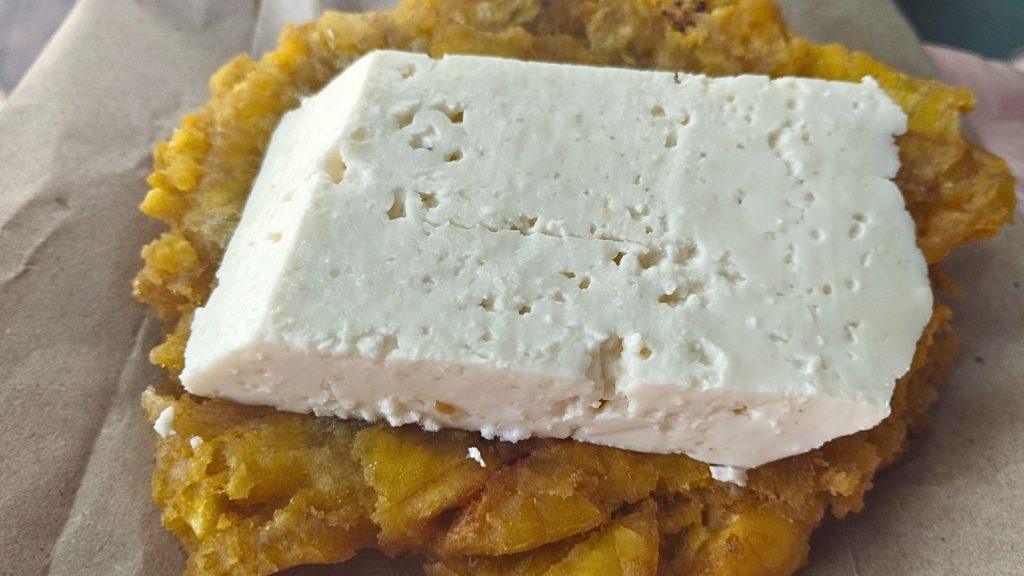
Typical sweets
Colombia has many varieties of sweets, and this is evident at the Portal de los Dulces or de los Mercaderes, in the arcades of Plaza de los Coches, where stall after stall of local vendors – mostly women- present their creations in glass jars, packages to take home as souvenirs, or assorted boxes to try a little of everything.
The women behind the counters, who have been coming from nearby towns to sell their wares for countless years, are a testament to the tradition and importance of this street and the duckets sold here, with a stall at each pilaster. This portal is a must if you have a sweet tooth, and there is no street food tour in Cartagena de Indias that skips it.
Alegrías, cocadas of different flavors (pineapple, coconut, guava, panela, arequipe, milk), milk preserves, cabellitos de angel, tamarind balls, sesame bricks, banana preserves, suspiros, sesame nugat, pastas… A varied tray is perfect to taste the wonders of this street, another of the most important of the gastronomy of the region.
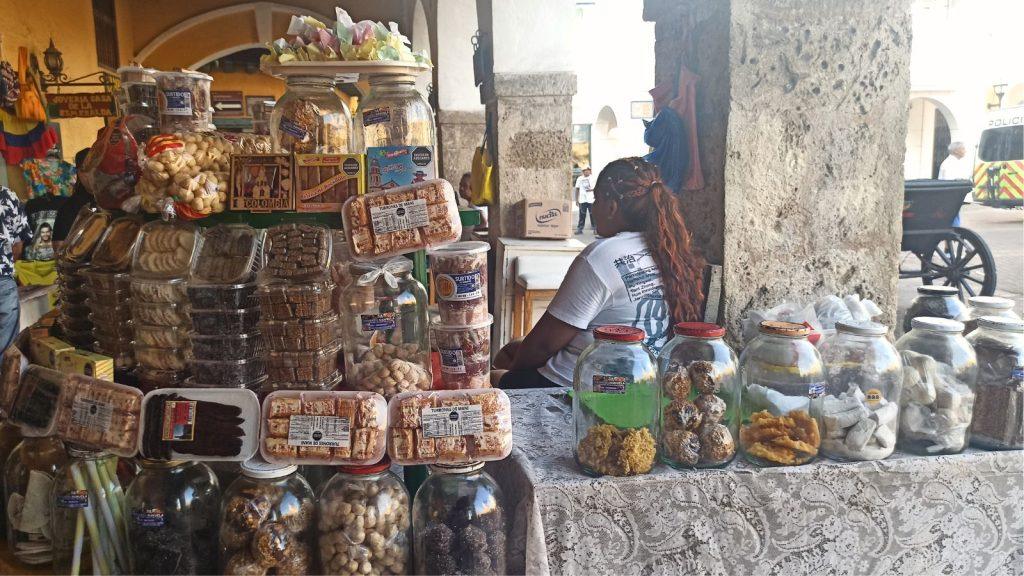
Buñuelos (fritters)
Another of the many sweets that are not only typical of Cartagena, but also present in this city, are the buñuelos, a sweet dough ball, although with cheese aftertaste – like so many other Colombian breads, see pandebono or almojábanas -, this heavy snack is halfway between a sweet and a salty snack, as long as it is eaten alone.
They are typically filled with either dulce de leche or chocolate, which removes the salty taste and makes them the perfect snack for those sweet lovers. The price is usually around 2,000 pesos and you can find them in bakeries, street stalls and kiosks.
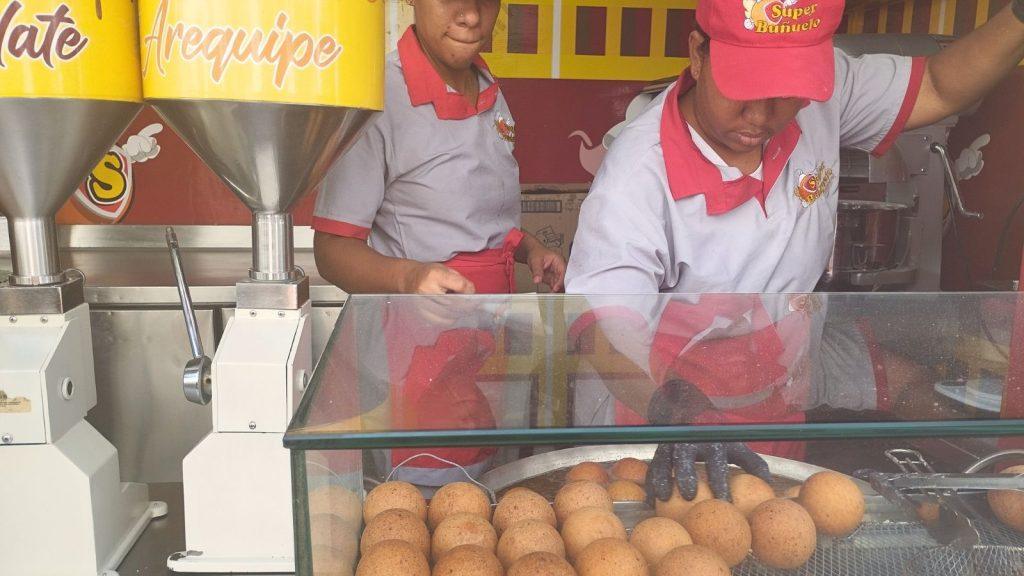
Lemonade, tangerine, and coconut water
Among the typical street food in Cartagena de Indias, there is also room for drinks. On the streets you will see many locals -mostly men – with small carts of soda or other juices. The most typical is lemon, but you may also see tangerine or other fruit juices, depending on the season.
I have read many testimonies of people who are afraid to drink these juices because of the ice that keeps them cold, but I have to say that in my experience – I drank several – I did not have a problem. In any case, the tap water in Colombia is safe to drink in the cities, but not recommended in thw towns or more natural areas.
I encourage you to try them because besides being delicious, they are perfect to beat the heat. It is also very typical to see cars with coconuts, so if you prefer to cool down with coconut water and avoid drinking the water from those ice cubes, you will have it easy.
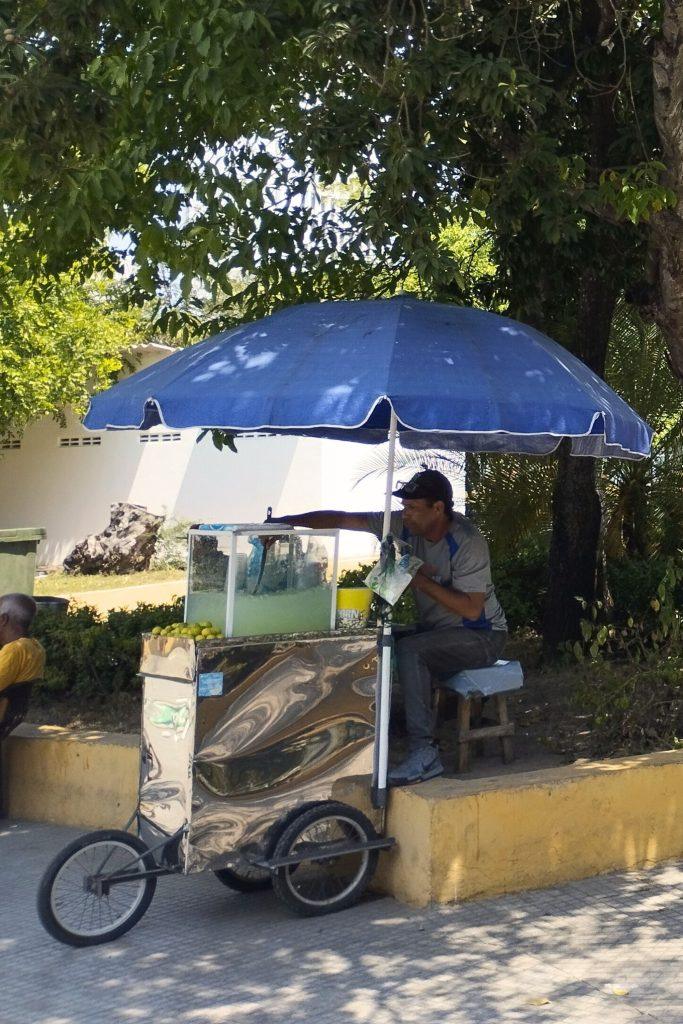
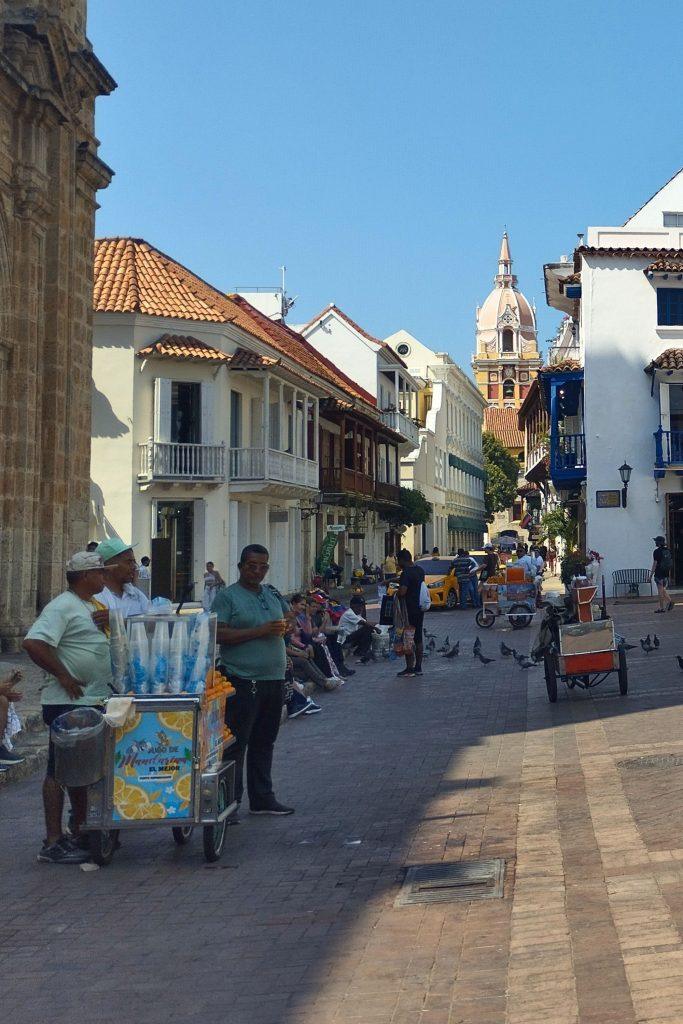
Perritos, salchipapa, and revoltijo
As you approach the Plaza de la Trinidad in Getsemaní – one of the coolest places to see in Cartagena de Indias – and wait for the sun to set, you’ll see the food carts and stalls crowding the sides of the square, one next to the other, in an orderly mesh of chaos.
This fast-food street food, however, is perfect for a pre-party dinner in Cartagena, great for soaking up the beers or cocktails you’ll probably be drinking in the square. Dishes like salchipapa, hot dogs, various meats, cheese and lots of sauce, patacones with meat, hamburgers…
Each stand has several options, and there are more than 15 stands to choose from, so you just have to find the one that catches your attention and you’ll have your dinner ready in about five minutes. It’s an experience that is part of downtown Getsemaní, so don’t miss it, it’s super fun!
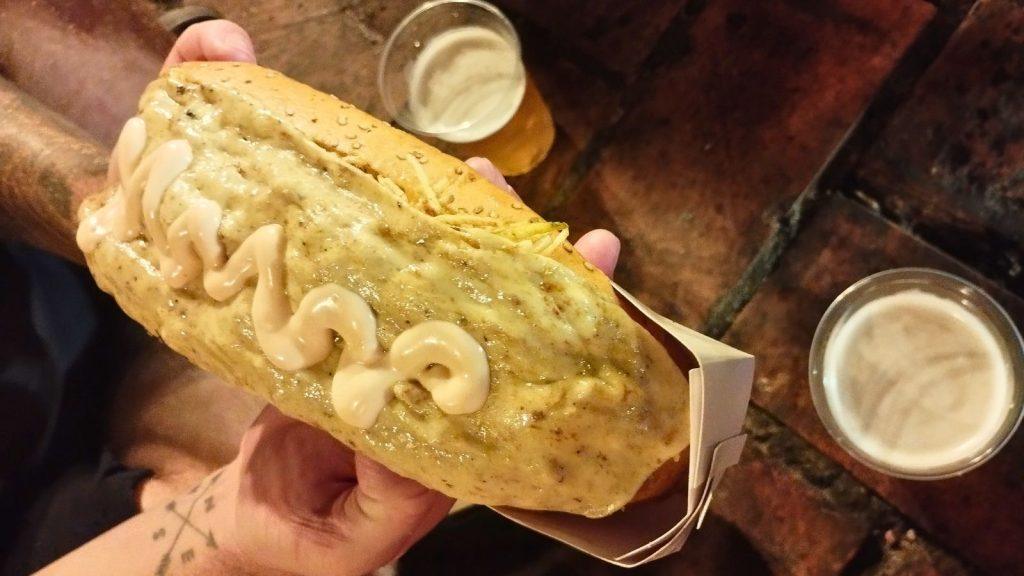
Typical street food beyond Cartagena de Indias: other Colombian snacks and tastes
Other street food suggestions in Cartagena de Indias that you will be able to find, but that are not originally from the city, include drinks like Cali’s typical lulada, a refreshing mix of juice, slush and fresh fruit, made exclusively with lulo, an exotic fruit with a sour taste.
Fruit dishes such as cholado, also from Cali, is a kind of fruit salad to which sweeteners such as sugar, condensed milk and syrups are added and mixed with shaved ice. It is not extremely sweet, but not as refreshing as lemonades or luladas.
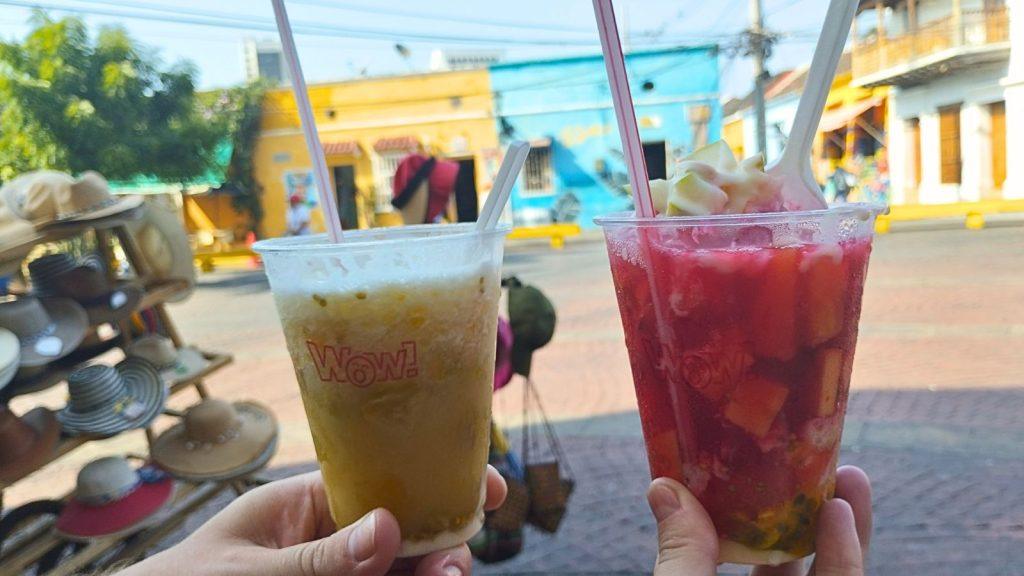
Maracumango ice cream, which combines the flavors of two of the richest and most beloved fruits of this part of the map, can be found in the form of a popsicles.
Sausages and grilled chorizo, served with an arepa or polenta and a squeeze of lime, although perhaps not a typical street food dish of Cartagena de Indias per se, can be eaten mainly at lunchtime, with several street food stalls offering it in the squares.
If you are looking for a berak from arepas and fried foods, it is a good way to fill up on protein with Caribbean flavors. We had it at one of the stands in the small square between Calle 36 and Avenida Venezuela, in front of the Oro Star store, which you will like if you are looking for a good Colombian atmosphere.
What other dishes would you add to this list of typical street food in Cartagena de Indias? What snack would you not miss when walking around the city? Tell me and I’ll write it down for my next visit ro Cartagena de Indias!

